The Evolution of the Permanent Collection
The permanent collection of most public museums comprises acquisitions that originate through either purchases or gifts. Palm Springs Art Museum’s collection is no different.
We have been fortunate to receive important gifts of art from a number of donors over our more than 80-year history, and you will see many of these works on view when you visit the museum. Works of art offered as donations are researched and vetted by the curators and director, and then considered by the Collections Committee comprised of members of the Board of Trustees and other specialists before being recommended by the full board.
Palm Springs Art Museum’s world-class collection currently totals over 16,000 objects concentrated in areas of Architecture and Design, Art of the Western Americas, Modern and Contemporary Art, Photography, and Studio Glass. The collection also includes architect Albert Frey’s iconic masterpiece Frey House II, located on the hillside above the museum.
Additionally, the museum houses over 50,000 items in special collections, comprising archival and other materials, such as architectural drawings, photographs, historical objects, and ephemera directly related to the collection. These special collections serve as primary source material for the museum’s curators and for researchers.
The History: In 1967, the board voted to officially add fine art as a museum collecting focus. After that decision, Olga and trustee Joseph Hirshhorn donated the first modern art acquisition, a 1966 untitled gouache on paper by Alexander Calder. This established the fine art collection and many other art donations followed. In 2005, Palm Springs Desert Museum adopted a new name—Palm Springs Art Museum—to reflect its exclusive focus on fine art with a multidisciplinary performing arts program.
There have been a number of extraordinarily generous individuals and families whose significant contributions of artworks and of architecture have been critical to building and growing the strong collection we have come to treasure here in Palm Springs.
Below, we trace the evolution of the permanent collection through this series of transformational gifts, significant art donors, and the shaping of our artistic legacy for the future.
Cornelia White and the White Sisters
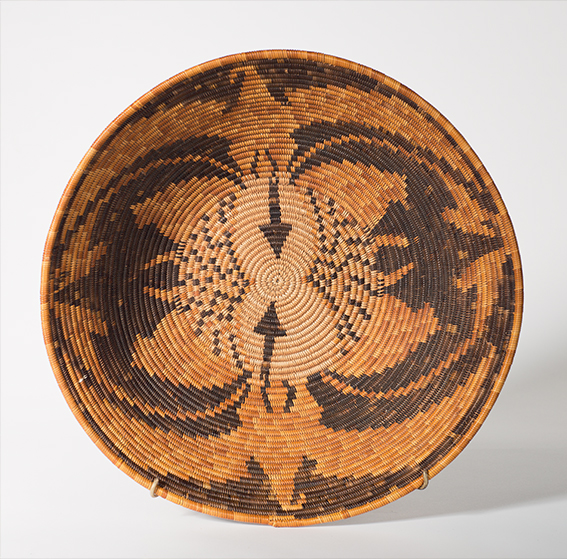
Lupe Alberras (Cahuilla, Santa Rosa Reservation, active first quarter 20th century), Rain and Sun Eagle Basket, ca. 1910, sumac, natural and dyed juncus on a deer grass bundle foundation, 4 1/2 × 16 1/4 inches. Gift of Cornelia B. White from the Marjorie Rose Dougan Collection, A95-1974.
The White Sisters—Cornelia, Florilla, and Isabel—grew up in Utica, New York. Dr. Florilla White and her sister Cornelia visited Palm Springs in 1912 before moving here the next year. Together, they purchased the Palm Springs Hotel property from Dr. Welwood Murray as well as the block south on Tahquitz Drive after his death in 1914. Isabel joined them here in 1915 and married author and photographer J. Smeaton Chase in 1917.
Cornelia was one of the earliest supporters of the museum and she donated the property on Tahquitz Drive—which was worth $75,000 in 1947 and abutted the Welwood Murray Library—to the Palm Springs Desert Museum. A surplus army building was moved to the site from the WWII hospital at the El Mirador Hotel and provided a home for the museum for the next decade. A new 10,000 square-foot facility—designed by two local architectural firms Williams, Williams, and Williams with Clark, Frey, and Chambers—was then built on the site and opened in 1958. The main floor gallery was dedicated to Miss Cornelia White for her contributions to our museum’s first permanent home.
Cornelia additionally donated more than 135 works of art to the museum. Some were given during her lifetime, and then The Cornelia White Collection was donated from her estate by Isabel in 1962. These gifts included a large group of Native American materials—in particular, Cahuilla basketry, Navajo and Pueblo blankets and rugs, and a selection of pottery. The collection features significant works by a number of Cahuilla basket makers, who were considered to be among the greatest in North America, including Dolores Lubo, Dolores Patencio, Guadalupe Arenas, and Lupe Alberras.
White also purchased 43 important baskets for the museum from the collection of Marjorie Rose Dougan. In addition to works by Alberras and Lubo, this group includes pieces by Dona Tortes, Fanny Casseras, and Cleo Torres, among others. The identification of a large number of basket makers gives particular stature to The Cornelia White Collection.
Herbert E. Toor and the Toor Family
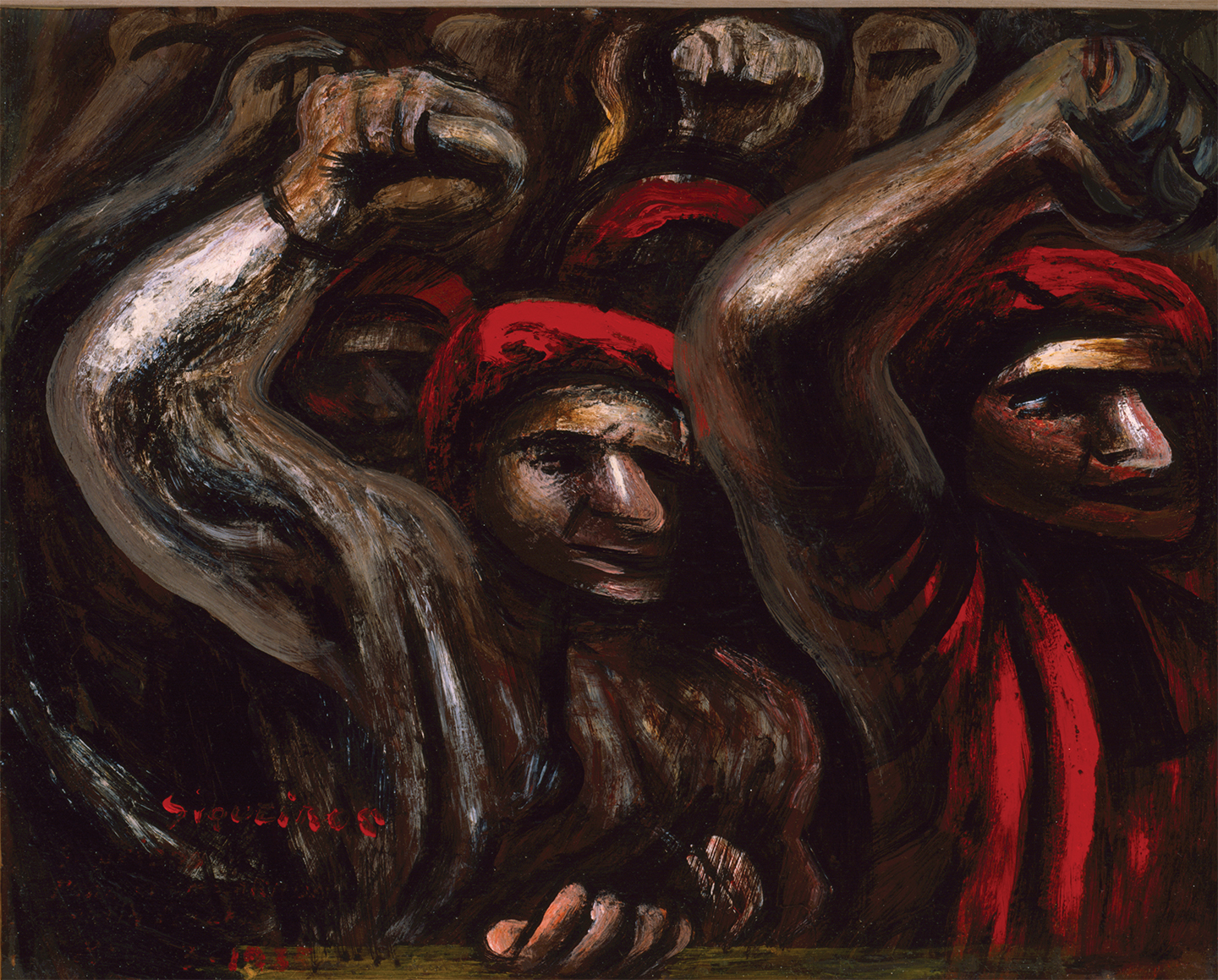
David Alfaro Siqueiros (Mexican, 1896-1974), Marcha Revolucionaria (Revolutionary March or Protest),1935, pyroxylin on copper, 18 5/8 × 22 × 1 1/2 inches. Gift of the Estate of Herbert E. Toor, 27-1989.
Trained as an engineer, Herbert E. “Bud” Toor became interested in furniture and started a furniture guild in 1934. It expanded into the Furnishings Mart in Los Angeles, which he founded and directed. As a philanthropist, he supported many desert organizations, events, and charities, including serving as a museum trustee from 1978-1988.
After his death in 1989, the museum received the Herbert E. Toor Estate gift, including works by Mexican painters such as Diego Rivera, David Alfaro Siqueiros, Jesús Guerrero Galván, Federico Cantú, and Fermín Revueltas—a collection that comprises the strength of the museum’s Mexican modernist works. The Toor bequest also includes a collection of Mesoamerican objects that augmented the museum’s pre-historic objects, featuring a significant Zapotec Mortuary Urn, ceramics from Nayarit, Colima, Chupícuaro, and various items from Peru.
Additionally, Marvel and Herbert Toor gave donations to support the expansion of the museum, including a gallery on the lower level, the green room of the Annenberg Theater, and the Toor Library in the Marks Administration Building—all of which are named in their honor.
Herbert’s sister Frances was an author, publisher, anthropologist, and ethnographer, whose books and the journal Mexican Folkways introduced Americans to the folk traditions and art of revolutionary Mexico. Her collection included black-and-white photographs, pre-Columbian objects, paintings and works on paper by Mexican modernists, and other artworks. It was inherited by Herbert following her death in 1956 and became part of the Toor gift.
George Montgomery
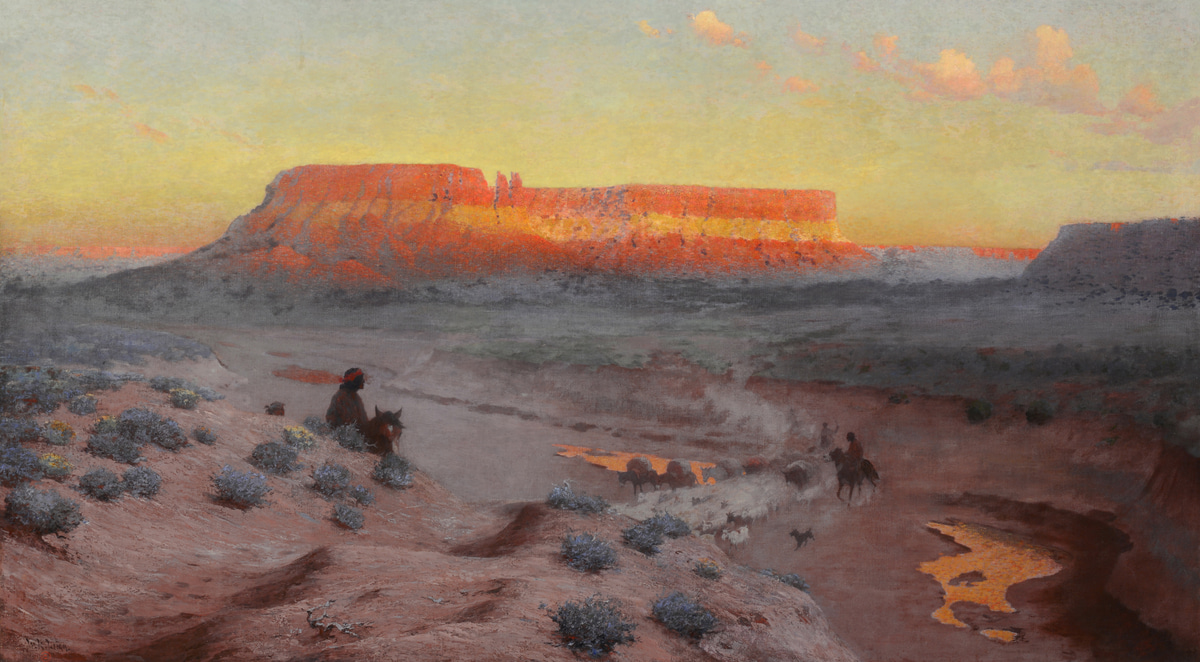
William Robinson Leigh (American, 1866-1955), Thunder Mountain, ca. 1910, oil on canvas, 40 1/2 × 72 1/2 inches. Museum purchase with funds provided by the George Montgomery Acquisition Fund, 2014.59.
Actor George Montgomery was a long-time supporter of the museum, a collector of traditional Western American art, and also an artist and furniture craftsman himself. He is best remembered as an actor in Western films and television. Montgomery visited Palm Springs regularly in the 1950s and lived here in later years, forming a strong connection to the community and to the museum.
As part of its commitment to the Art of the West, in 1996 the museum hosted a major exhibition, George Montgomery: Actor–Artist–Collector, featuring prominent paintings, sculptures, and works on paper from his collection. His own original works and movie memorabilia were also included. Numerous installations of Montgomery’s collection continued during his lifetime and since.
Four years after his death in 2000, the museum received a bequest from the George Montgomery Trust consisting of over 150 objects, including art works by such prominent artists as Thomas Moran, Frederic S. Remington, Charles M. Russell, Joseph Henry Sharp, William Robinson Leigh, Grace Carpenter Hudson, Edgar Payne, and Frank Tenney Johnson. These pieces form the core of the museum’s classical American Western art collection.
His Hollywood-influenced romance with the American West as a frontier led him to appreciate and collect Native American textiles. In his home, they complimented the works of classic American paintings and sculptures. Notable among these textiles are two early twentieth-century Navajo rugs that were included in the bequest and represent an important chapter in the history of reservation trading posts. This major gift to the museum also included bronze sculptures made by Montgomery, as well as finely handcrafted furniture made in his Hollywood, California workshop, where he employed and trained as many as 20 woodworkers. Additional objects representing his studio practice and his film career memorabilia augmented those works.
William Holden
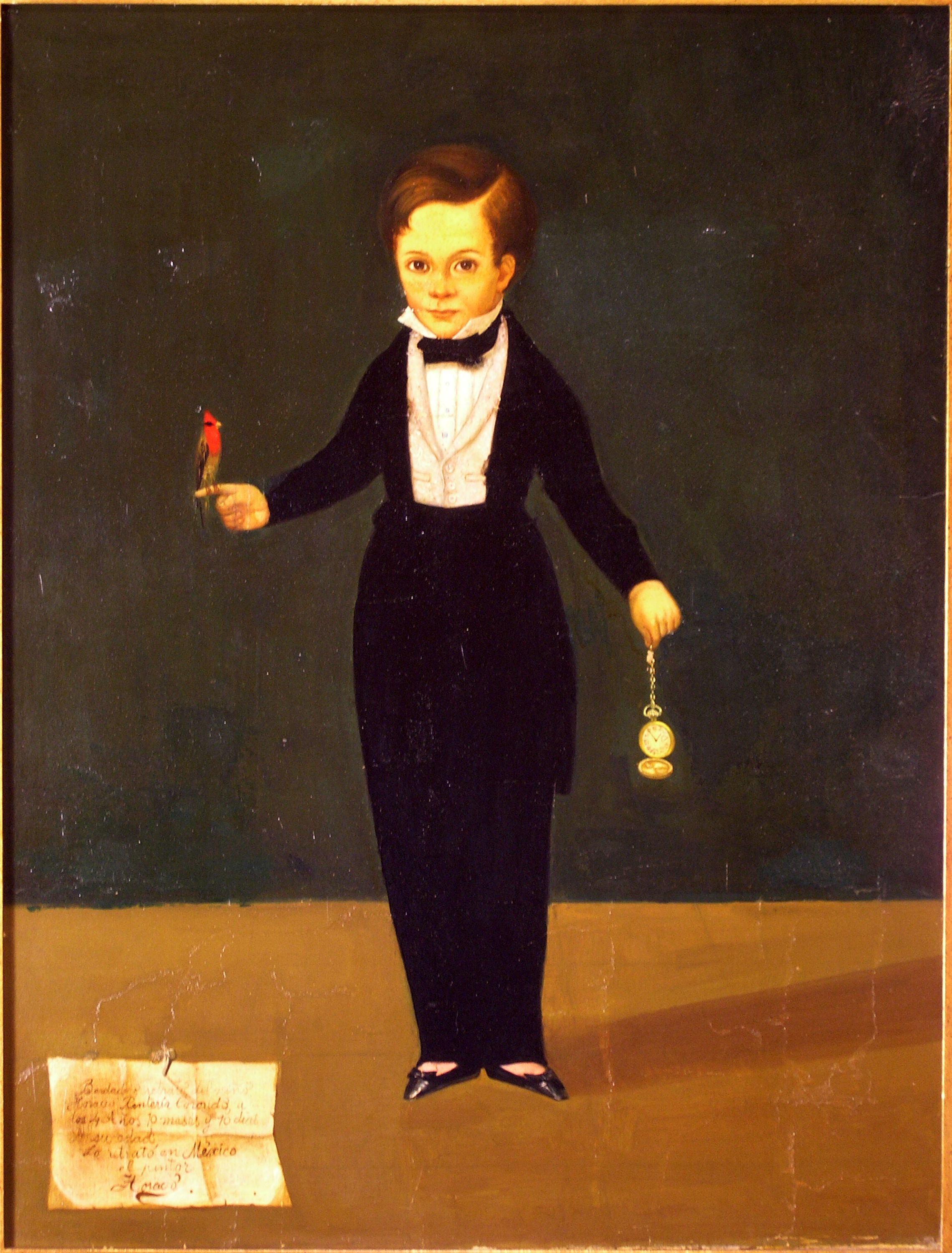
Horacio, Young Boy with Bird and Gold Watch, n.d., oil on canvas, 23 1/8 × 17 1/2 inches, Palm Springs Art Museum, Gift of the William Holden Estate, 10-1983
The museum received a collection of over 100 art objects from William Holden’s estate following his death in 1981. The Academy Award-winning American actor and Hollywood star appeared in over 70 films, including Sunset Boulevard, The Bridge On the River Kwai, and The Wild Bunch. He maintained a home in Palm Springs as well as in Switzerland and was devoted to issues of wildlife conservation, creating the William Holden Wildlife Foundation. His Palm Springs Southridge residence was co-designed with local modernist architect Hugh Kaptur in 1977 and served as a showplace for his art and artifacts.
Though his collecting interests varied, his focus generally comprised ancient Egyptian, Greek and Roman works and figures, African and Asian objects (including headdresses and masks), sculptures, paintings, and decorative arts (including textiles and tapestries, ceramics and porcelain, furniture and screens). Many of these works originated from Japan, China, Thailand, Tibet, India, Burma, and Cambodia—reflecting his travels and his lifelong curiosity about world cultures.
Additionally, Holden had an interest in modern art which he also donated to the museum. These works include a small bronze sculpture by Auguste Rodin, a sculpture by Gerhard Marcks, and a lively and colorful watercolor painting by Raoul Dufy, among others. Many of these objects were displayed in his home during his lifetime. After his death, period-style room displays were recreated within the museum’s galleries to showcase these works and to represent the lifestyle of this Hollywood star.
Bill Anderson
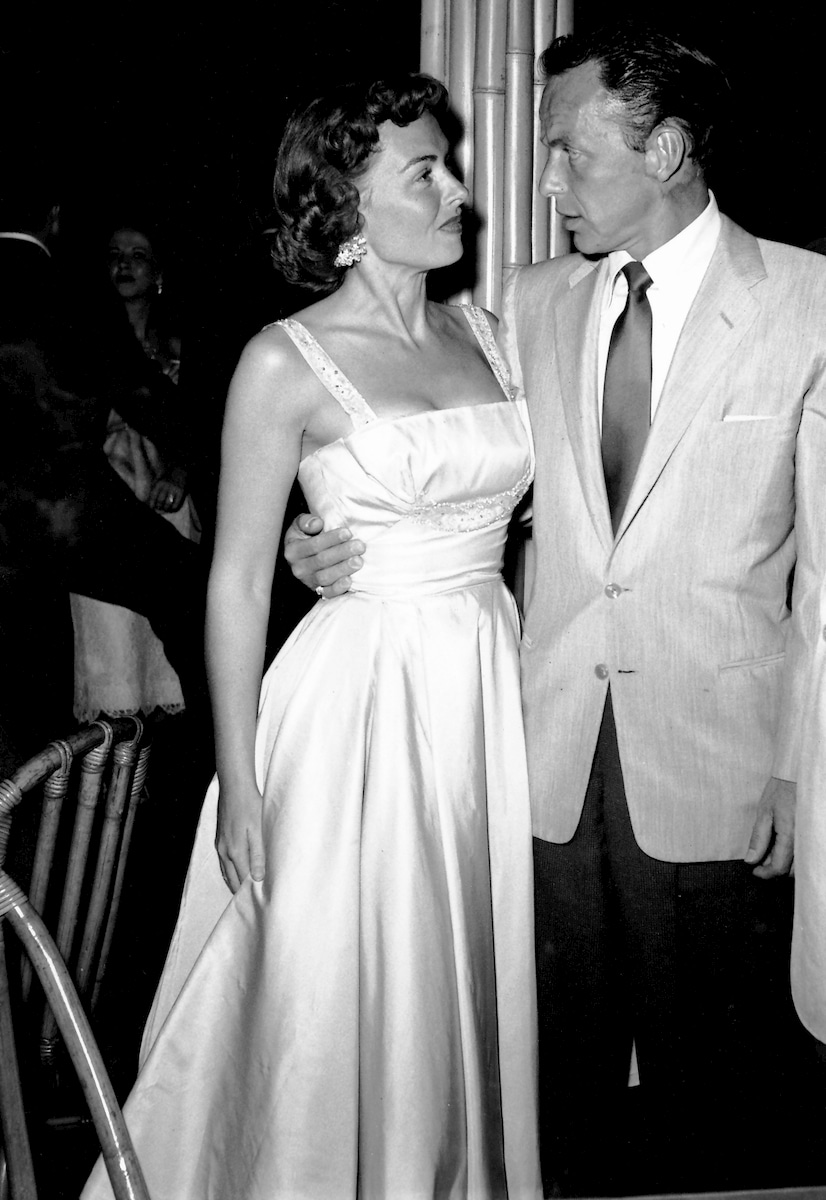
Bill Anderson (American, 1923-1971), Donna Reed and Frank Sinatra, 1954.
Gift of Mrs. Dorothy M. Anderson, R91-2001.12.
The work of acclaimed Palm Springs “Photographer-of-the-Stars” William (Bill) Anderson encapsulates the emergence of Palm Springs as a Hollywood playground from the late 1940’s through the 1960’s. Anderson was a photographic technician in the U.S. Navy during World War II, and studied photography under Ansel Adams at Art Center College of Design in Pasadena. He then entered the Los Angeles photographic studio of Bruno Bernard, known as “Bernard of Hollywood.” In 1950, Anderson purchased the business and archive of the Bernard Studio in Palm Springs including the Racquet Club of Palm Springs account, which provided Anderson with exclusive poolside access to photograph famous and elite movie personalities. Anderson operated the business as Bernard Anderson and later Anderson Studios until his death in 1971.
Anderson created memorable images of the Hollywood crowd at leisure—swimming, playing tennis and golf, and enjoying other activities. He captured prominent celebrity personalities such as Judy Garland, William Holden, and Ava Gardner. His signature style set them against the breathtaking beauty of the mountain and desert scenery, meant to add an exotic glamour befitting the Hollywood mythos and a lifestyle associated with the movie industry. Many of these photos were included in the Racquet Club’s newsletter. His other clients included the Palm Springs Tennis Club, Palm Springs Villager and later Palm Springs Life magazines, and the Palm Springs Chamber of Commerce.
In 1975, Anderson’s widow Dorothy donated the entire contents of his studio, which consisted of over 30,000 negatives, contact sheets, vintage prints, and copyright to Anderson’s work. His photographs have been featured in museum exhibitions devoted to celebrity images, including the recent online presentation about Anderson’s work and Backyard Oasis: The Swimming Pool in California Photography, 1945-1982, a significant publication and exhibition at the museum that was part of the Getty’s Pacific Standard Time initiative in 2012.
Stephen H. Willard
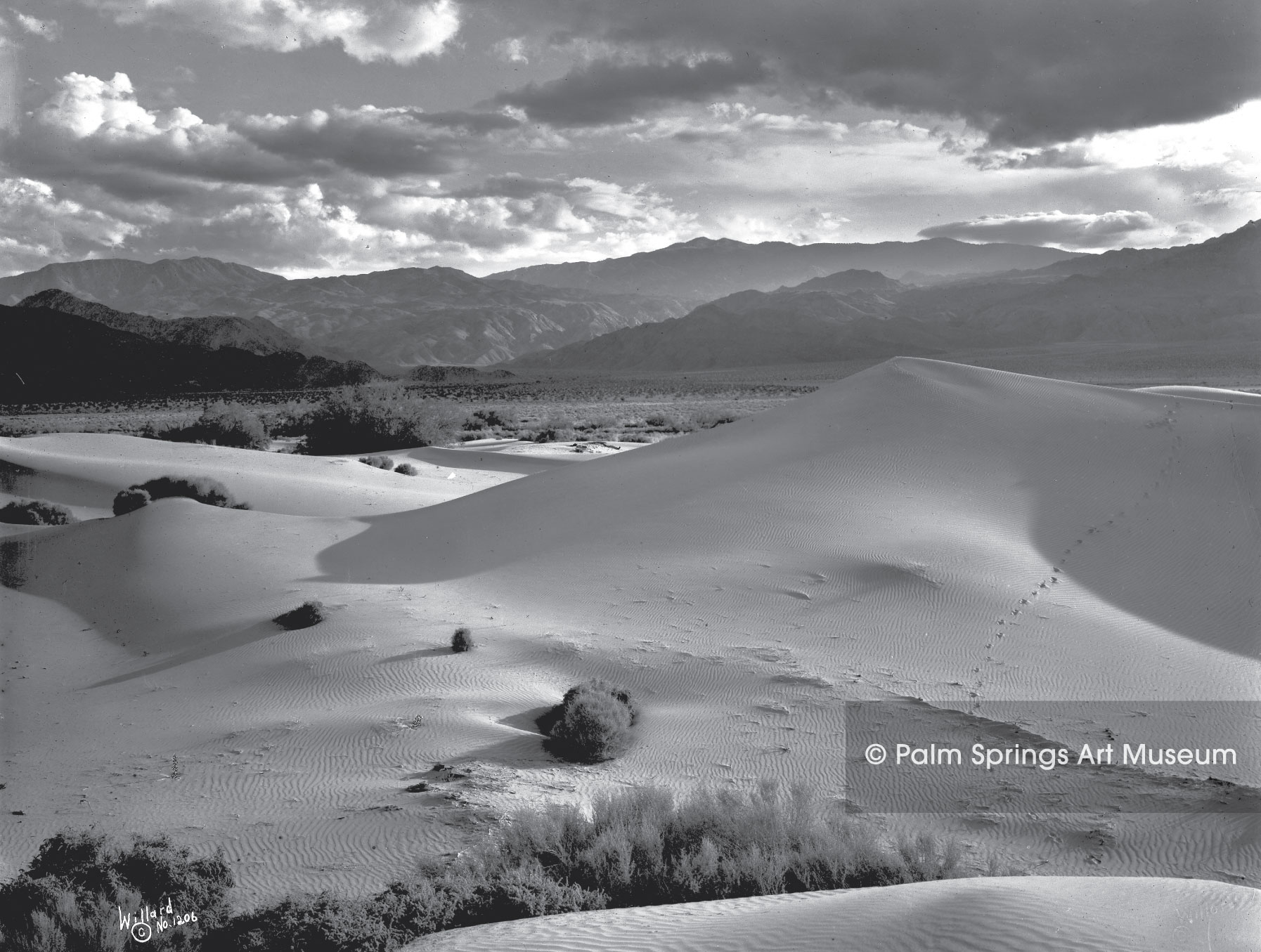
Stephen H. Willard (American, 1894-1966), Sand Dunes with Santa Rosa Mountains in background, c. 1925,
film negative, Willard No. 1206. Gift of Dr. Beatrice Willard, Willard XB24. © Palm Springs Art Museum.
Stephen Hallet Willard photographed the deserts and mountains of Southern California and the West for more than five decades. Raised in Corona, California, he learned photography during high school. In 1921, Willard married Beatrice Armstrong; they traveled and photographed the Southwest for a year, and then settled in Palm Springs, where they opened a studio and gallery. For the next 25 years, Willard traveled throughout the Mojave and Colorado Deserts of California, photographing the environmental details of the region. In time, Willard and his wife established a second studio and gallery in Mammoth Lakes; he photographed mountain topographies in the summer and desert terrains in the winter.
Willard‘s images preserve a historic record of the area, but he was also an early proponent of photography as a fine art. His choice of subjects, creative use of composition, and ability to capture sharp tonal contrasts combine to make his black-and-white landscape images valuable artistic statements. Willard was also a pioneer in the development of painted photographs—a process by which he mounted enlarged photographs on Masonite board and applied oil paint over the prints.
In 1999, Dr. Beatrice Willard donated her father’s life’s work, along with an endowment, to the museum. This generous gift of The Stephen H. Willard Photography Collection & Archive contains over 16,000 original glass and film negatives, vintage photographs, hand-colored lantern slides, photo-paintings, postcards, stereographs, cameras, lenses, and other photographic equipment. The gift also includes personal papers, memorabilia, photo albums, maps, traveling cases, correspondence, and publications. These materials provide endless opportunities for research about Southern California and the Southwest, and have been included in multiple exhibitions.
The Weiner Family
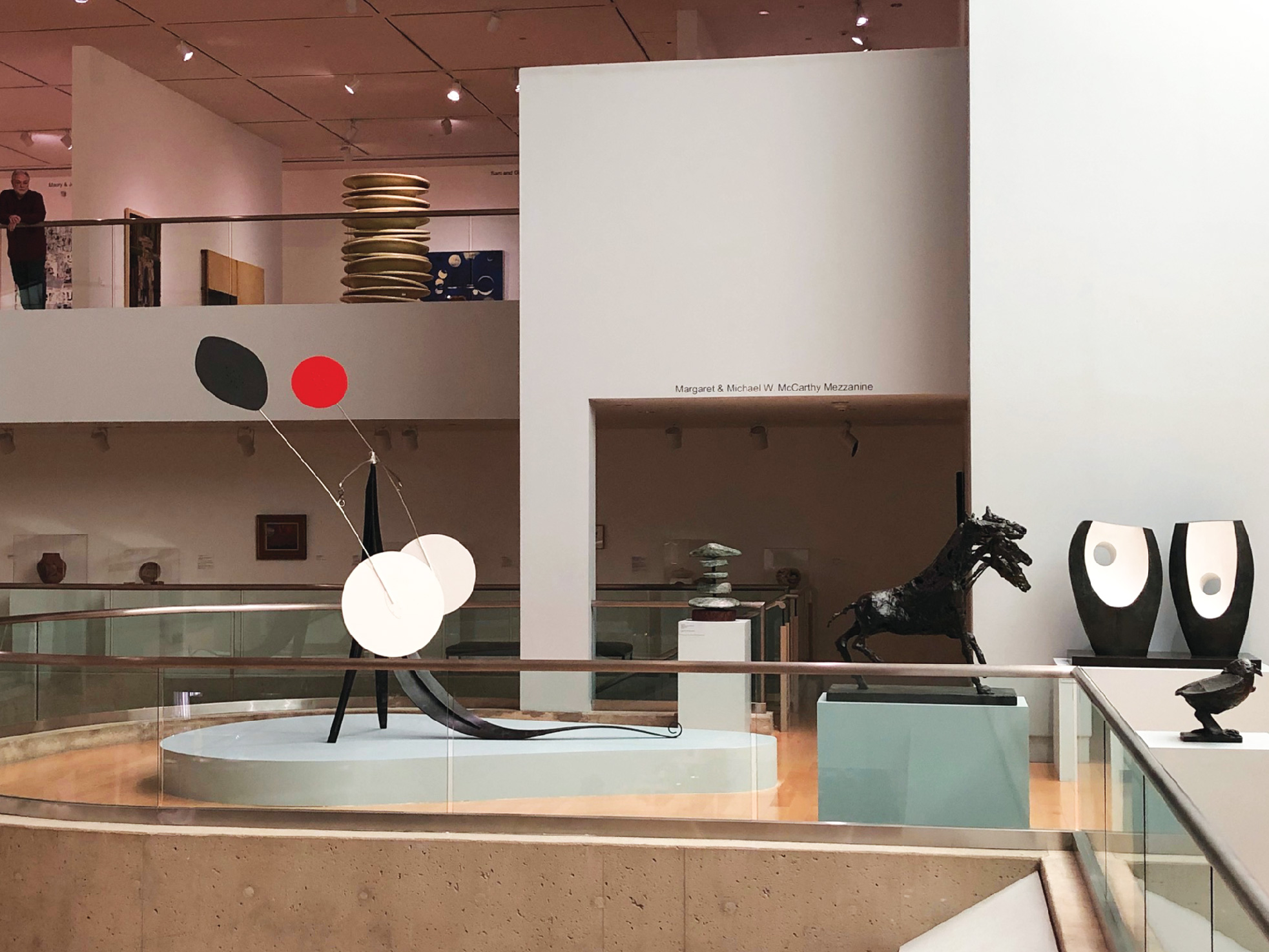
Alexander Calder (American, 1898-1976), Lizard (Lézard), 1968, steel, aluminum, iron, paint, 104 ½ x 165 x 31 ¾ inches. Gift of Gwendolyn Weiner in honor of Harold Meyerman, 80-2011. © 2020 Calder Foundation, New York / Artists Rights Society (ARS), New York.
The museum’s relationship with the Weiner Family began with Ted and Lucille Weiner in the late 1960s. They were among a group of forward-thinking art collectors who turned the museum into an outstanding cultural center through their philanthropic support and gifts of art. Ted Weiner, a Texas oilman, assembled one of the most significant collections of modern sculpture west of the Mississippi. Since 1969, much of his family’s art collection has resided at the museum—initially as loans and increasingly as gifts.
The Weiner Family Collection—with its emphasis on 20th-century American and European sculpture—initiated the museum’s focus on modern art. Their gifts have included major sculptures by such well-known modern masters as Jean Arp, Jacques Lipchitz, Pablo Picasso, Marino Marini, Henry Moore, Germaine Richier, and Peter Voulkos, as well as paintings by Marc Chagall, Rufino Tamayo, Franz Kline, and Adolph Gottlieb. Ted and Lucille’s daughter Gwendolyn has continued her parents’ legacy of generosity and patronage through regular donations of art, including Henry Moore’s Two Piece Reclining Figure No. 3 and Alexander Calder’s Lizard, which are prominently displayed in the museum. Gwendolyn is a board trustee and, during the 2015-2016 season, the museum presented A Passionate Eye: The Weiner Family Collection, featuring over 60 works of art from the collection, accompanied by a major publication. These important artworks have long provided a foundation for the museum’s identity as a world-class arts institution.
Donna J. MacMillan
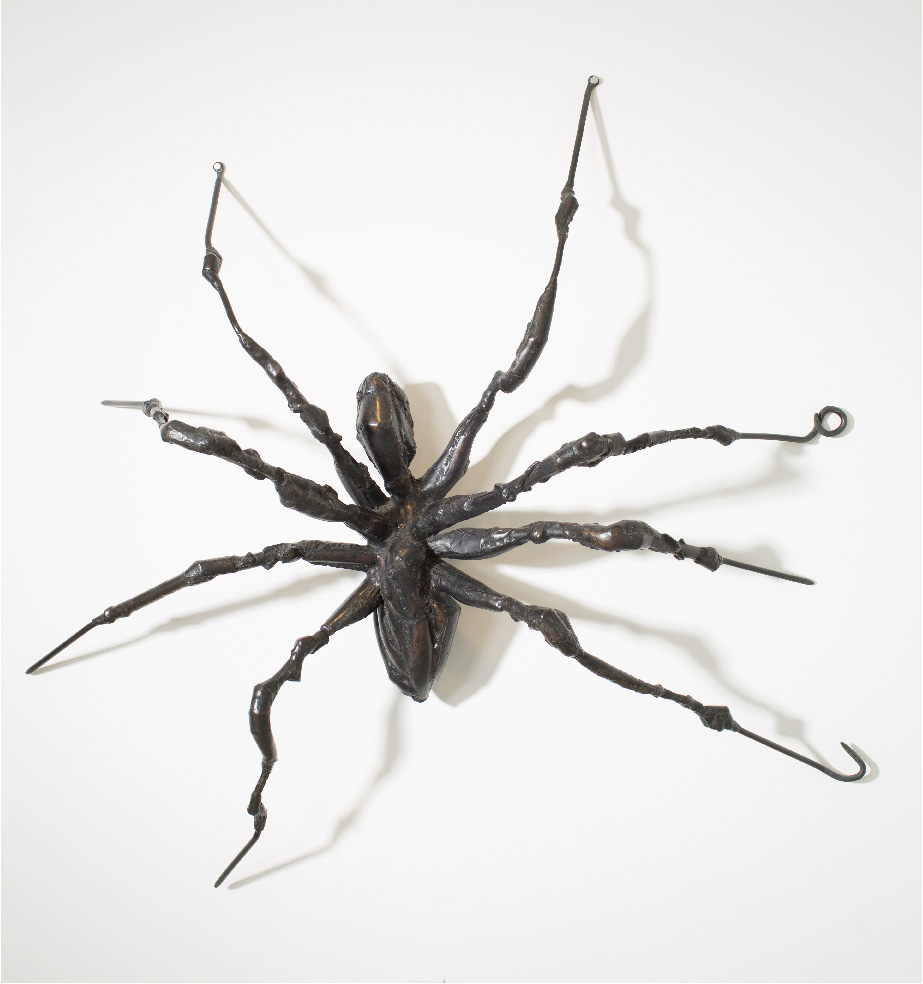
Louise Bourgeois, Spider II, 1995, Bronze, edition 4/6, 73 × 73 × 22 1/2 in., 75th Anniversary gift of Donna J. MacMillan. 113-2013. © The Easton Foundation / Licensed by VAGA at Artists Rights Society (ARS), NY
Donna MacMillan and her late husband Cargill, Jr. began visiting the museum in the mid-1980s. From their earliest involvement, the MacMillans were advocates for their collecting passion: modern and contemporary art. In 1993, Donna joined the Board of Trustees and has since participated in many committees and leadership roles, including Chair of the Board from 2015 to 2018 and is now Chair Emerita. Throughout, she has been dedicated to making the museum known for its world-class contemporary art holdings, adding to the collection significantly through gifts as well as funds to support purchases of art.
Of prime importance was the transformative contribution of over 100 gifts and promised works of art from the MacMillans’ personal collection in 2009. Their donation included major works by artists associated with the leading developments in European and American art from the 1960s to the present, including Andy Warhol, Jim Dine, Louise Bourgeois, Anselm Kiefer, Antony Gormley, Teresita Fernández, Anish Kapoor, Gary Hume, Mona Hatoum, Tokujin Yoshioka, the Campana Brothers, and Gavin Turk. These artworks shifted the contemporary focus of the museum’s collection from primarily California-based to a wider international reputation, and raised the prominence of the contemporary holdings to the level that the Weiner family had previously established for the museum’s modern collection.
This major gift by the MacMillans was celebrated in the 2009-2010 exhibition and catalogue The Passionate Pursuit: Gifts and Promised Works From Donna and Cargill MacMillan, Jr. The exhibition filled the entire Steve Chase Wing on the third floor and the Marks Graphics Gallery on the lower level. Many of these works can be seen in the galleries today, including Louise Bourgeois’ Spider II, 1995, perched on the third floor and visible throughout the museum.
Steve Chase
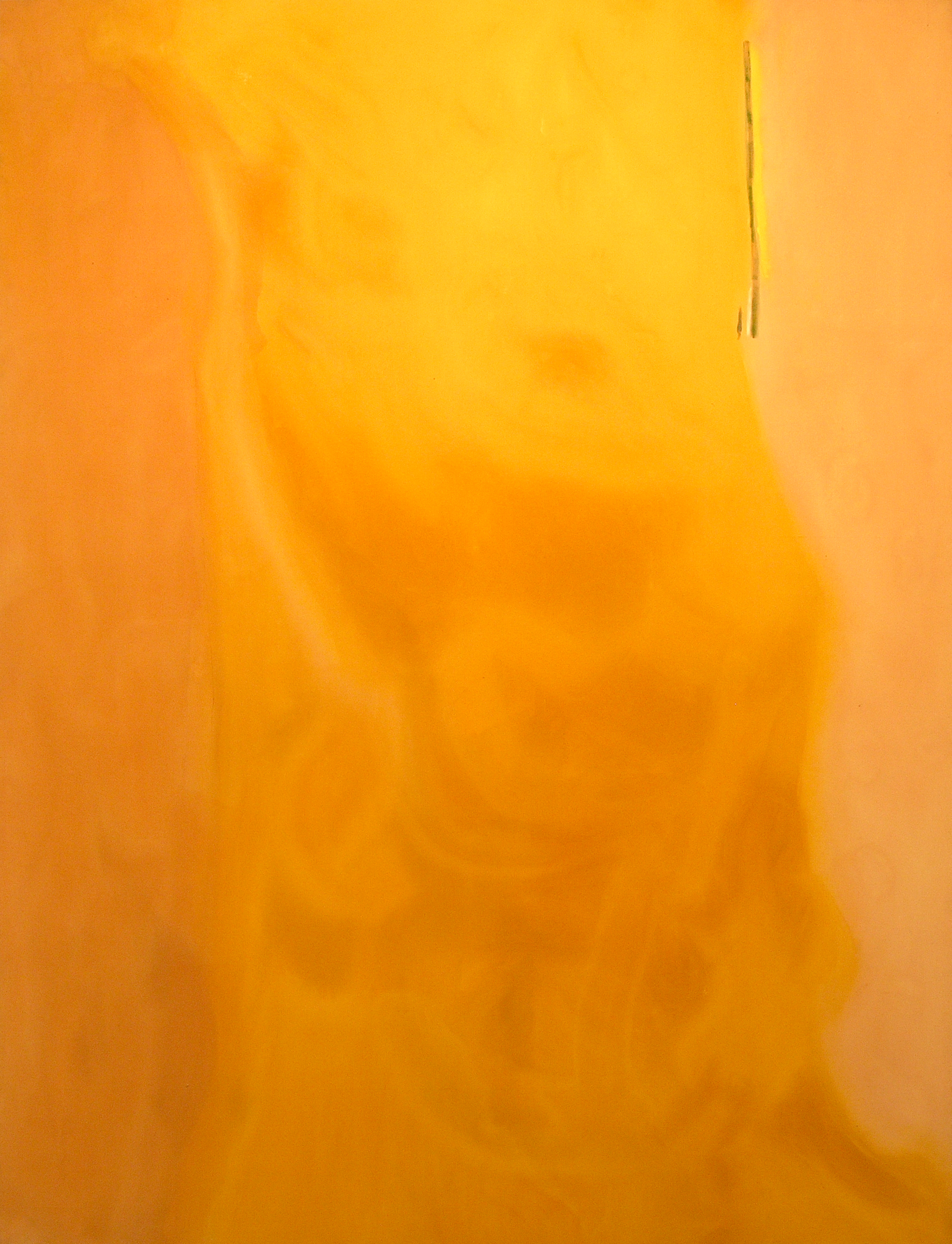
Helen Frankenthaler (American, 1928-2011), April Screen, 1972, acrylic on canvas, 121 ¾ x 84 ½ inches. Gift of Steve Chase, 33-1981.
A celebrated interior designer and humanitarian, Steve Chase loved contemporary art, incorporating it into his everyday design philosophy. In 1967, he came to work in the Palm Springs office of Arthur Elrod Associates, contributing his own sensibility to the firm’s reputation for a daring use of materials. In 1980, Chase established his own interior design firm in Rancho Mirage. He encouraged his clients—including celebrities Dyan Cannon, Farrah Fawcett and Johnny Mathis—to purchase artworks from practicing artists or their art dealers for their interiors, rather than decorative pieces that would harmonize with the surrounding furniture. Chase followed the same principle for his home, acquiring art works by modern artists including Jules Olitski, Helen Frankenthaler, and Sam Francis.
Chase was often drawn to California artists, and his holdings reflected that focus with works by John Altoon, Charles Arnoldi, Billy Al Bengston, and Ed Ruscha—as well as pottery by Van Briggle, J. A. Bauer, and others.
When Chase died in 1994, his close relationship with the museum resulted in a major donation that brought his total contributions to 133 artworks, along with a significant endowment, which in turn guaranteed the central role of contemporary art at the museum. Spurred by Chase’s generosity, a group of board members led an initiative to construct a new exhibition space for contemporary art. In 1996, the museum opened its expanded third floor galleries as the Steve Chase Wing with an inaugural installation of art from his gift. The recognition of Chase in Palm Springs Walk of Stars is installed in front of the museum entrance steps as a reminder of his enduring legacy to the museum and community.
David Kaplan and Glenn Ostergaard
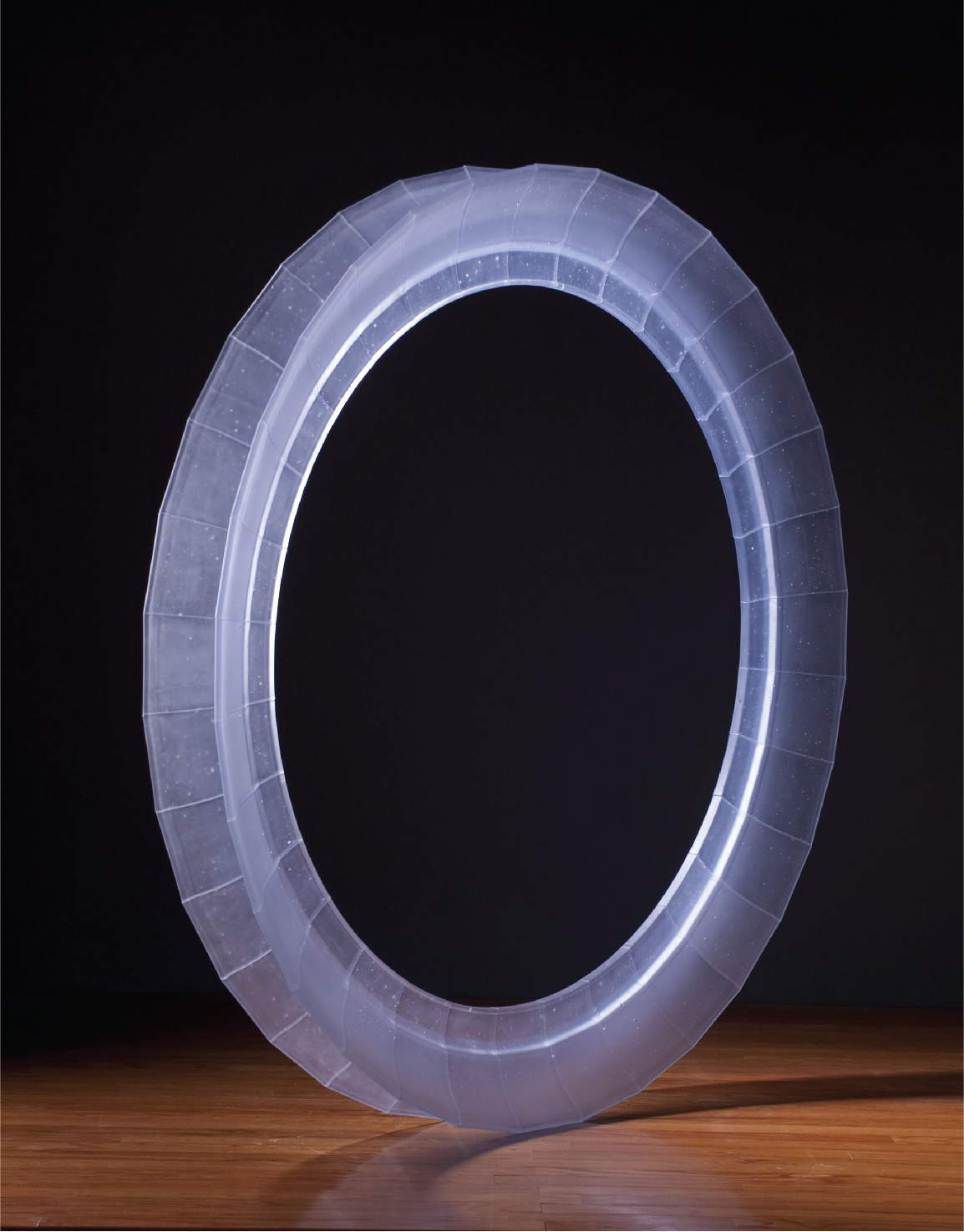
Daniel Clayman (American, born 1957), Circular Object 4, cast glass 69 1/4 x 69 x 7 1/2 inches. Museum purchase with funds provided by David Kaplan and Glenn Ostergaard, 23-2010.
David Kaplan and Glenn Ostergaard have a long history with philanthropy and the arts, and with the Palm Springs Art Museum. Kaplan has been a member of the Board of Trustees since 2001, and the couple established the museum’s Kaplan-Ostergaard Glass Center in 2007. Sharing their enthusiasm for studio glass with others who became Founding Benefactors, they ensured the medium’s place in the collection and exhibition program.
Early on they shared a passion for Bay Area artists with their roots in the region’s Figuration and Funk movements, including Viola Frey, Joan Brown, Nathan Oliveira, Robert Bechtle, Manuel Neri, and Richard Diebenkorn. Later, while living in Australia, they developed an interest in studio glass, particularly the innovative works of Klaus Moje, Nick Mount, Matthew Curtis, Cobi Cockburn, Clare Belfrage, Richard Whiteley, Evelyn Dunstan, and Emma Varga. These artists and many others became the heart of their collection.
As their knowledge and appreciation of studio glass expanded, so did their collection, and they turned their focus to artists working in the medium around the world. This led them to collect renowned international artists including Lino Tagliapietra, Claire Falkenstein, Mildred Howard, Steve Klein, Stanislav Libenský and Jaroslava Brychtová, Karen LaMonte, Bertiel Vallien, and Vladimira Klumpar, among others. Their expanding collection has been featured in a number of museum exhibitions, including Glass for the New Millennium: Masterworks from the Kaplan-Ostergaard Collection (2016-2017), which originated at the Crocker Art Museum, Sacramento. Other exhibitions of their collection have been held at the Chazen Museum, Madison, Wisconsin; Museum of Glass, Tacoma, Washington; and Museum of Arts & Design, New York.
In 2019, Kaplan and Ostergaard donated 114 works of studio glass to Palm Springs Art Museum, substantially expanding the museum’s contemporary glass collection. Previously, they had added to the museum’s collection by donating work by Deborah Butterfield, Robert Bechtle, Viola Frey, Karen LaMonte, and Dan Clayman.
Albert Frey
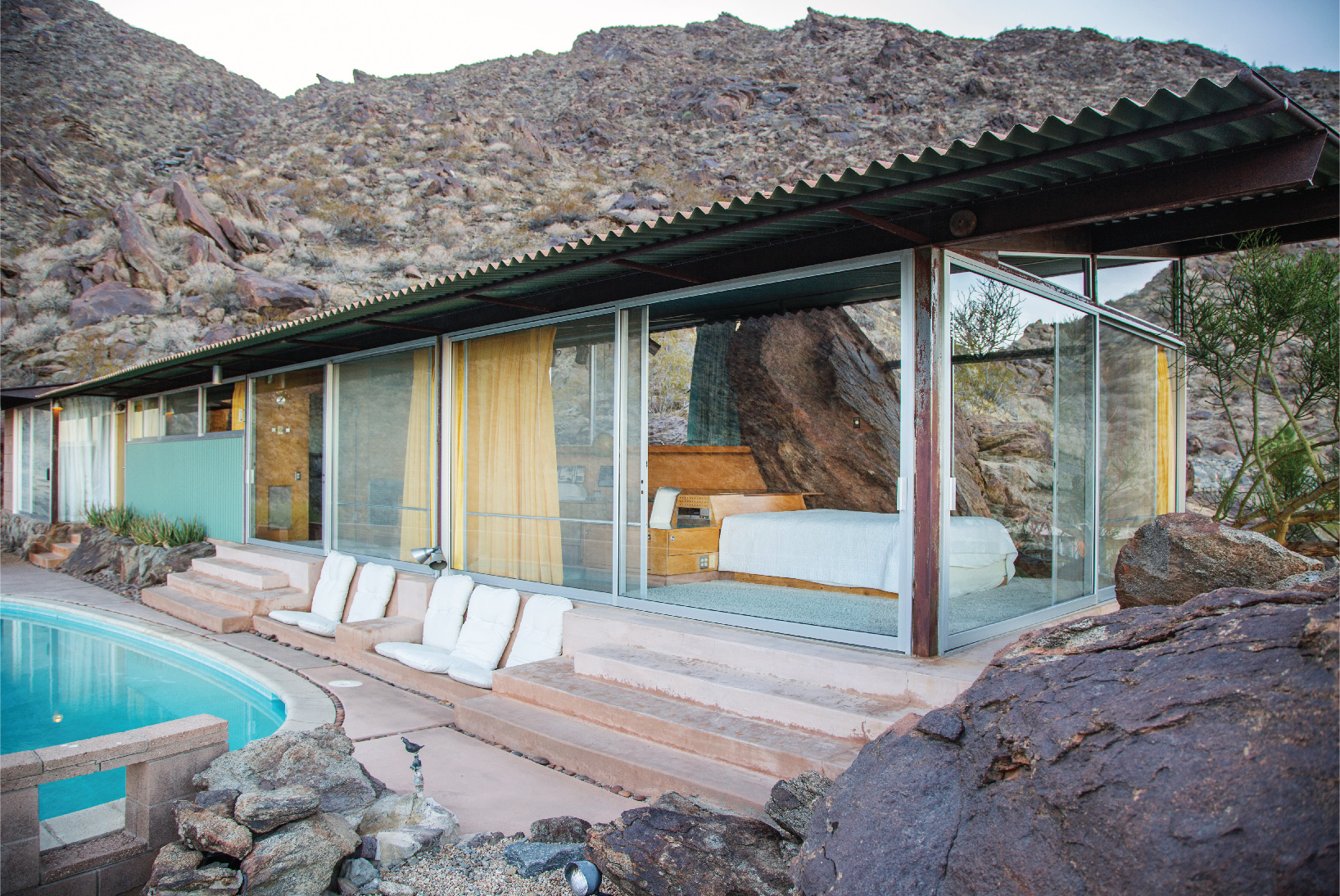
Albert Frey (American, born Switzerland, 1903-1998), Frey House II, 1963-1964, addition 1970-1971. Collection Palm Springs Art Museum, Bequest of Albert Frey, 55-1999.1. Photo by Bethany Nauert.
This Swiss architect’s association with the museum dates back to its origin and parallels the history of the city itself. Albert Frey, FAIA, first visited Palm Springs in 1934 to supervise the Kocher-Samson Building while working for architect and editor A. Lawrence Kocher. This inspired a lifelong fascination with the desert; Frey settled permanently here in 1939 and began working with architect John Porter Clark.
The first permanent home for the Palm Springs Desert Museum was designed by two local firms Clark, Frey and Chambers with Williams, Williams and Williams, who worked cooperatively on the project. Construction was completed in 1958, and the museum remained there until the move into our current building on Museum Drive in 1975. Between 1952-1957, Palm Springs City Hall was also being planned by the same to local firms, and was largely the vision of Frey, thought to be one of the most experimental of the Desert Modernists.
Frey bequeathed the Museum his home, Frey House II (completed 1964), which sits on the hillside above Museum Drive, as well as his archive of drawings, personal and working papers, photographs, scrapbooks and albums, and other documents. The archive has formed the basis of many exhibitions with more being planned. These materials have been supplemented by donations from other sources that have enriched our holdings and understanding of Frey’s legacy.
Frey was a member of the museum’s Board of Trustees from 1941-1945 and Board President from 1945-1946, as well as a founding benefactor. Frey married Marion Cook who was also a museum trustee from 1941-1943. In 2010, he was celebrated on the Palm Springs Walk of Stars alongside the Architecture and Design Center.
E. Stewart Williams Collection, and Sidney and Erik J. Williams
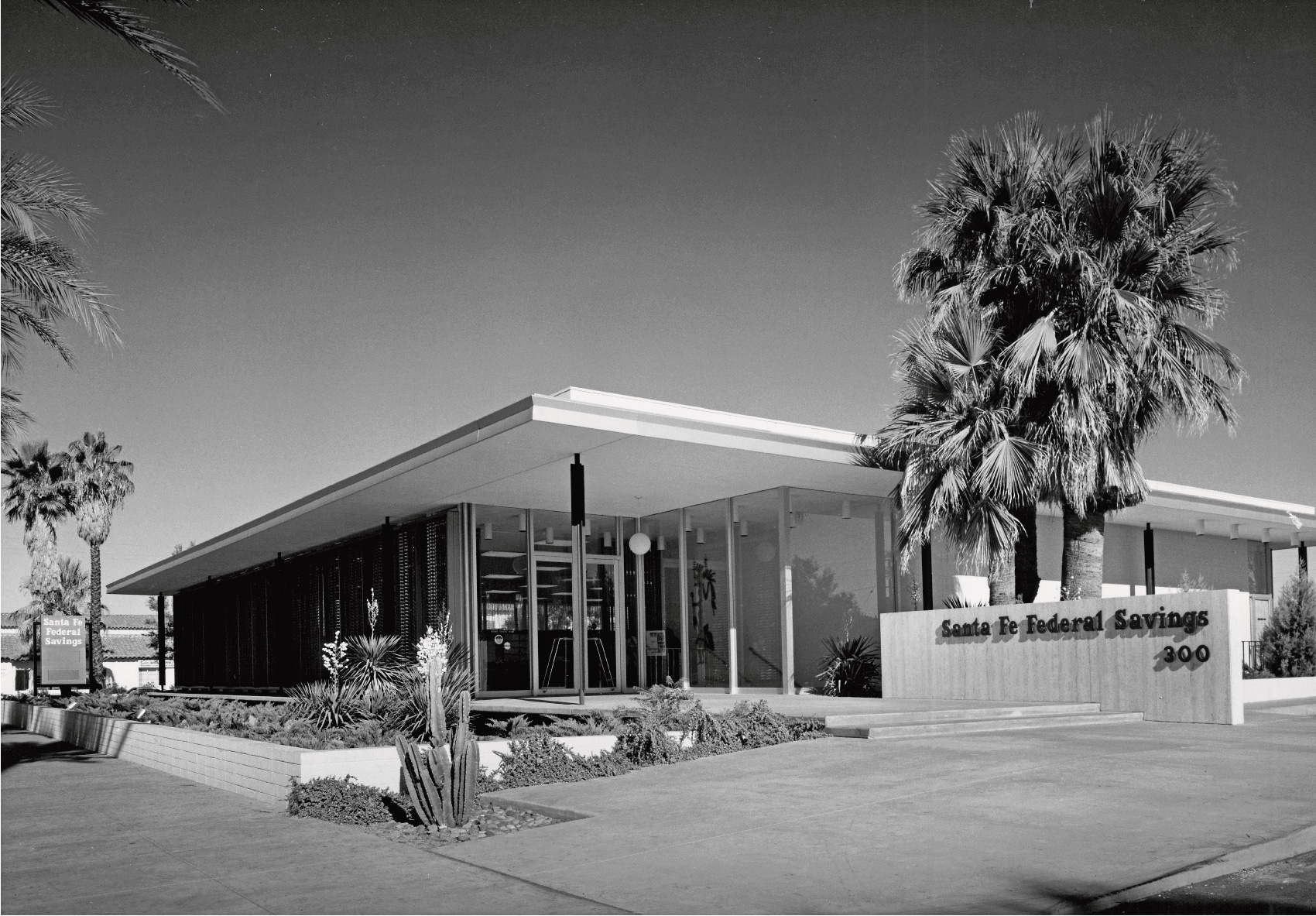
Julius Shulman (American, 1910-2009), Santa Fe Federal Savings and Loan Association, 1962, silver gelatin print, 8 x 10 inches. E. Stewart Williams. Gift of Dr. and Mrs. Erik Williams, S2015.4. © J. Paul Getty Trust. Getty Research Institute, Los Angeles (2004.R.10).
E. Stewart Williams, FAIA, is pivotal to the legacy of the museum. He not only designed our current home which opened in 1976, and its expansion in 1996, but also the Architecture and Design Center, Edwards Harris Pavilion, which was originally the Santa Fe Federal Savings and Loan Association building, built in 1960. His wife Mari was a Trustee from 1976-1989, served on the board of the Women’s Committee, and worked tirelessly on galas and programs.
In 2002, the E. Stewart Williams Collection was donated to the museum, and it has been supplemented by gifts from the architect’s family members: Mari Anne Williams Pasqualetti in 2015; Erik and Sidney Williams in 2015 and 2016; and Geoffrey and Linda Williams in 2016. It contains architectural drawings, photographs, project scrapbooks, awards, recordings, and other materials. This rich trove includes photographs by Julius Shulman, whom Williams commissioned to document his buildings. These resources illustrate the range of Williams’ architectural practice and the central role he played in shaping post-WWII architecture and design in the Coachella Valley.
Williams’s daughter-in-law Sidney Williams has been a driving force behind architecture and design at the museum. In her role as Director of Education and Public Programs, she created programming tied to the city’s built environment and educated the public about its architectural history. The now acclaimed Modernism Week developed in collaboration with community organizations during her tenure. She led the 2003 initiative to establish the Architecture and Design Council and its annual symposia, which she coordinated for many years. Becoming Curator of Architecture and Design in 2007, Sidney originated major exhibitions and publications, notably Steel and Shade: The Architecture of Donald Wexler (2011) and E. Stewart Williams: An Eloquent Modernist (2014). Under her energetic guidance, the museum opened its Architecture and Design Center, Edwards Harris Pavilion in 2014. In 2017, she received a well-deserved commemoration on the Palm Springs Walk of Stars, appropriately sited alongside the Architecture and Design Center.
L.J. Cella
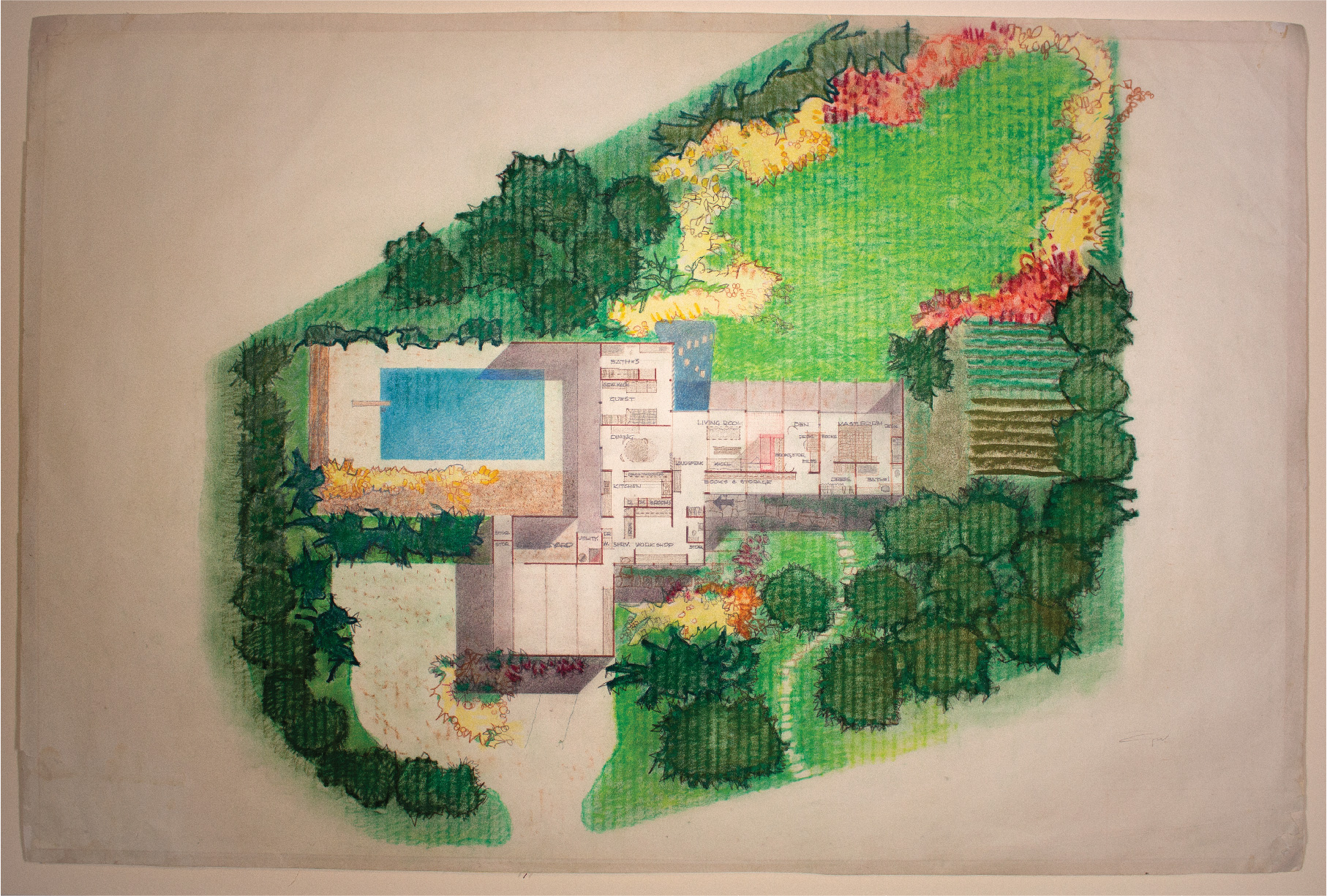
Richard J. Neutra, American (born Austria, 1892-1970), Oxley House, La Jolla, California, 1958, color pencil on paper, 24 x 35 3/4 inches. Gift of L. J. Cella, 13-2009.
L.J. Cella’s generous commitment to the museum was firmly established in 2010 with his transformational donation of 130 architectural and design drawings and eight photographs to support the institution’s growing emphasis in those areas. Reflecting the unique position of Palm Springs within midcentury modernism, many of these pieces are by iconic California figures, in particular Richard Neutra, Barry Berkus, and Lawrence Halprin. Cella’s interest in midcentury architecture also includes images by architectural photographers such as Julius Shulman, the pioneering artist of the medium. In an age when architectural practice now relies on digital methods, Cella has focused on drawings made by hand from an era before computers began to dominate the field. Cella’s attention to midcentury art and architecture also encompasses the era’s design, leading him to donate in 2013 fifteen signature pieces of glassware, textiles, and ceramics developed by renowned designer Alexander Girard for the famous La Fonda Restaurant in New York City.
However, Cella’s interests have extended beyond the midcentury to the work of architects and other practitioners such as Stephen Erhlich, Frank Gehry, Isabelle Greene, Tadao Ando, Daniel Libeskind, Richard Meier, and Marjetica Potrc; his donated drawings and objects by these figures have expanded the collection. His ongoing gifts also feature works by fine artists who engage more broadly with the concerns of architecture and design, including Alice Aycock, Vito Acconci, Dan Graham, and Phillip K. Smith III, and extend to artists including Chris Burden, Clare Rojas, Peter Alexander, and Robert Irwin.
A founding donor of the Architecture and Design Center, Cella served on the museum’s Board of Trustees from 2013-2017, helping to ensure the building’s launch and its programming. To date, he has donated over 200 objects to Palm Springs Art Museum.
H. Kirk Brown III and Jill Wiltse
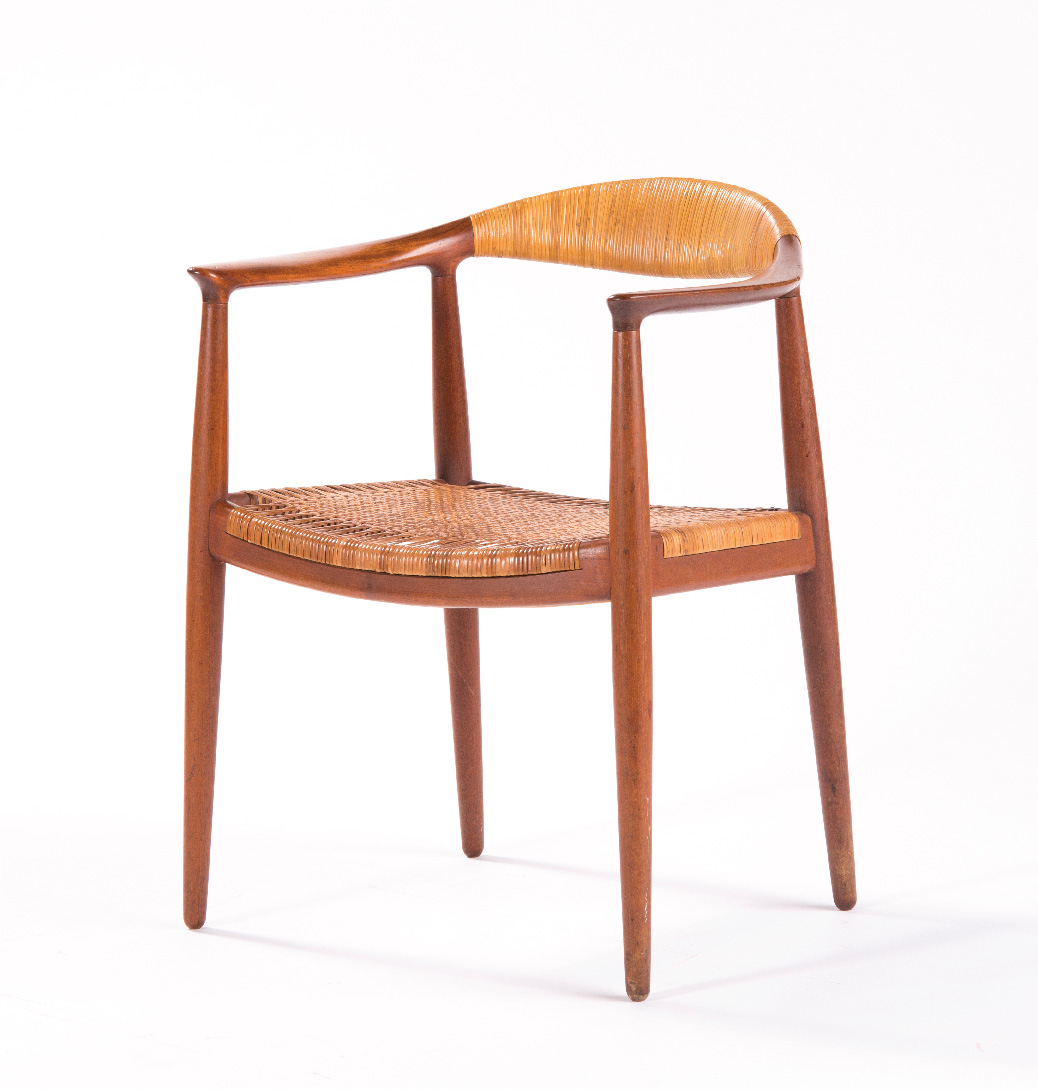
Hans Wegner (Danish, 1914-2007), The Round Chair, teak and cane, Manufactured by Carl Hansen & Son, Danish, founded 1908, 30 × 24 3/4 × 18 1/4 inches. 75th Anniversary gift of Jill A. Wiltse and H. Kirk Brown III, 2014-17. 2014.17.
Co-founders of Design On Screen, Jill A. Wiltse and H. Kirk Brown III established the company to promote, produce, and preserve quality architecture and design documentaries. Their first feature film, Desert Utopia: Midcentury Architecture in Palm Springs, with director Jake Gorst in 2008, set the stage for their successful series utilizing archival images, historic footage, and interviews with leading experts. Subsequent documentaries have featured significant practitioners like Donald Wexler, Hella Jongerius, William Kriesel, Lucienne & Robin Day, and E. Stewart Williams. Their most recent film, Albert Frey: The Architectural Envoy–Part II, premiered during Modernism Week in February 2020.
As Brown and Wilste traveled internationally, they developed an interest in domestic interiors and surfaces. A visit to Budapest in 1997 led to the couple’s impressive collection of early- to- mid-20th- century Hungarian paintings, furnishings, and décor that was exhibited in 2006, and is evident in their passion for designer Eva Zeisel. Together, they have amassed one of the largest collections in the country of decorative design objects, including furniture, ceramics, glassware, and textiles, which they have shared with a number of institutions that feature decorative arts and design, including Palm Springs Art Museum.
In conjunction with the museum’s 75th anniversary and in anticipation of our new Architecture and Design Center, the couple donated 144 objects and helped to champion the center as founding members and patrons. Their gifts included works by renowned ceramicists Alexander Girard, Gio Ponti, Ben Seibel, Mary Wright, and complete dinnerware and glassware sets by both Russell Wright and Eva Zeisel. Their gift also included iconic midcentury textiles by Lucienne Day, Maija Isola, and Russell Wright. Their generous collection donation provides an important cornerstone to the design holdings of the museum’s collection.
Dr. J. Patrick and Patricia A. Kennedy
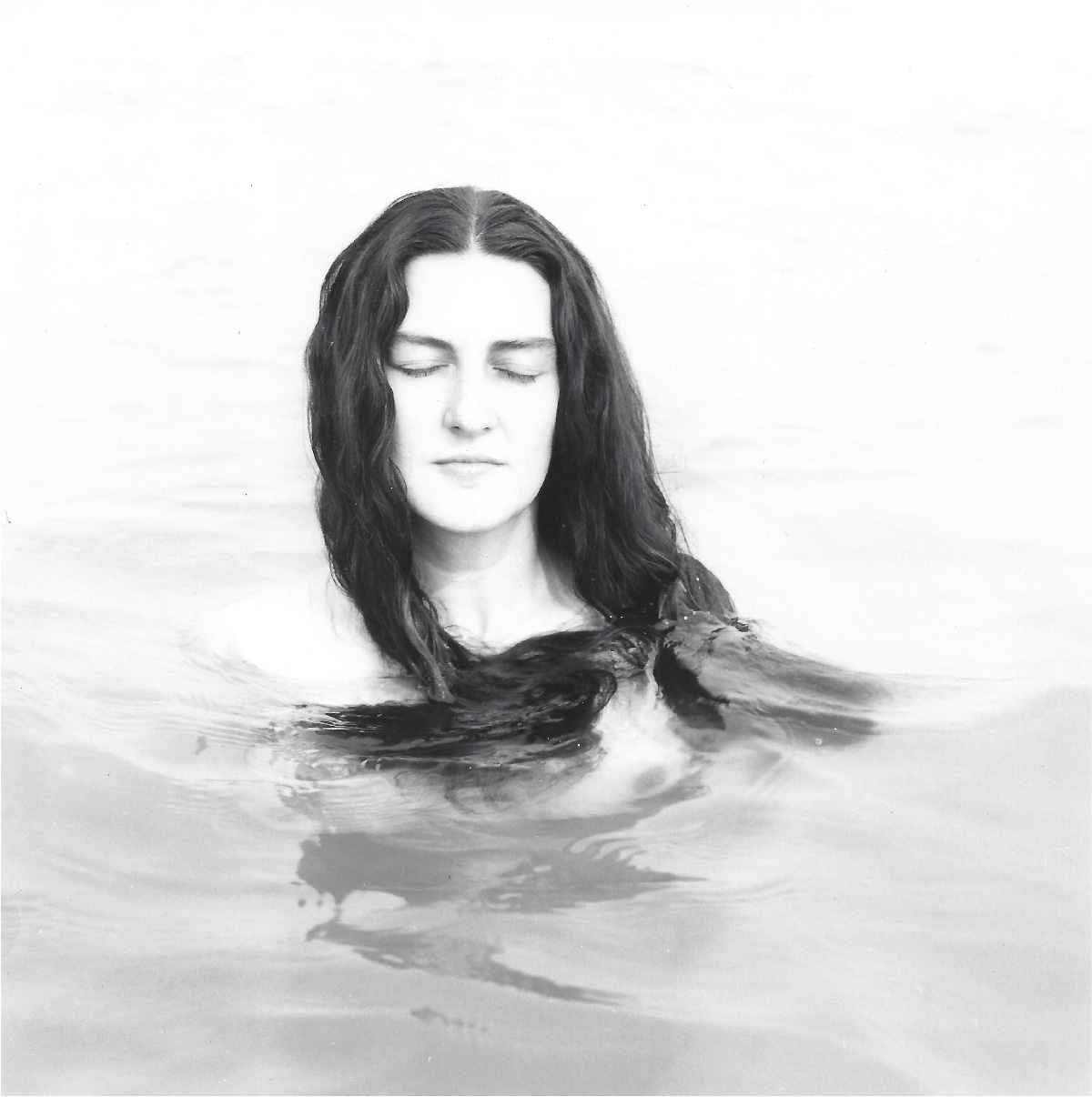
Harry Callahan (American, 1912-1999), Eleanor, Chicago, 1949, gelatin silver print, 8 x 6 3/4 inches.
Gift of Dr. and Mrs. J. Patrick Kennedy, 32-2008.
Dr. J. Patrick and Patricia A. Kennedy have donated more than 850 works of photography to the Palm Springs Art Museum. This included an important gift in 2007 consisting of limited-edition books and 543 original photographs dating from the 19th century to the present. This gift represents the work of nearly 100 photographers and is one of the largest photography donations ever to the museum, enhancing the ability to tell a history of photography from its inception to the present. Their daughter Jenny Linton was also a donor of photographs in 2017. The Kennedy contribution comprises international photographers working in a range of processes, including albumen, platinum, gelatin silver, solarized gelatin silver print, photogravure, c-prints, and dye transfer.
Their gifts over the span of a decade significantly elevated the museum’s growing photography holdings, which previously had been concentrated largely in two areas: celebrity photographs from the 1930s to the 1960s in Palm Springs and Hollywood, and desert photography featuring the archival holdings of landscape photographer Stephen H. Willard. The scope of the Kennedys’ gift ranges from early views of Egypt and the Holy Land by Francis Frith and photographs of Rome by James Anderson from the 1850s and 1860s, to contemporary prints by artists such as Duane Michaels, Nan Goldin, Milton Rogovin, Joel Peter Witkin, and Arthur Tress. The gift also comprises strong examples of work by early 20th-century Pictorialists, including Heinrich Kuhn, Julia Margaret Cameron, Alfred Stieglitz, and Edward Steichen, and modernist masters such as Paul Strand, Andre Kertesz, Andreas Feininger, Helen Levitt, Brassai, and Harry Callahan. Selections from the collection were displayed in the 2009 exhibition at the museum, Modern Moments: Recent Gifts in American Photography from Bonino, Fauci, and Kennedy.
Joe and Pamela Bonino
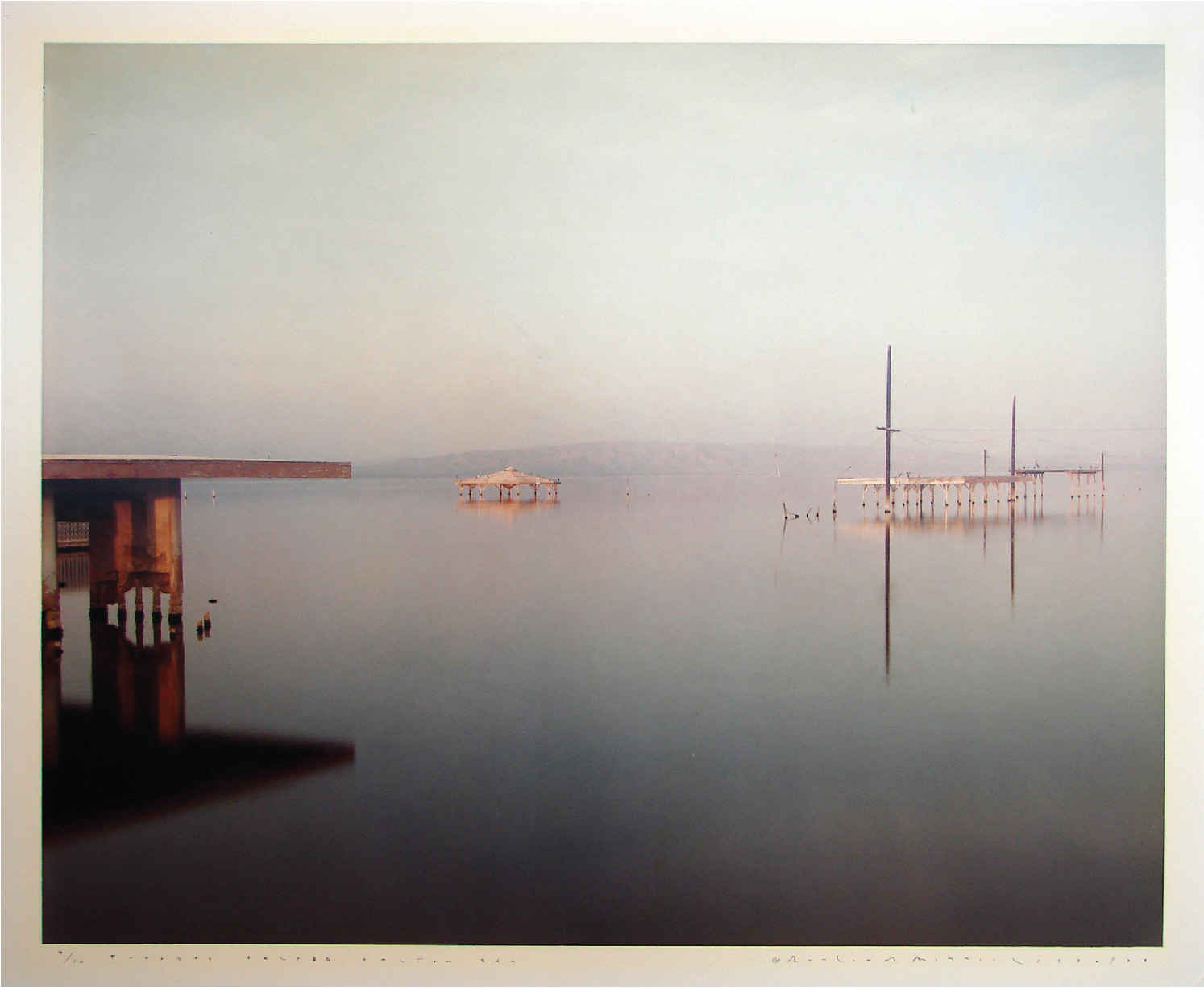
Richard Misrach (American, born 1949), Flooded Gazebo Salton Sea, 1986-1988, dye coupler print, edition 4/10, 30 x 39 7/8 inches (sheet). Gift of Joe and Pamela Bonino, 2-2007.
Joe and Pamela Bonino have given more than 85 works of art to Palm Springs Art Museum. They met in San Francisco in the early 1970s, where they lived until 2008, and became involved with the museum in 1979. Pamela began to collect photography in the 1980s, and after involvement with the Photography Accessions Committee at San Francisco Museum of Modern Art and other Bay Area institutions, she was one of the founders of the Photography Council at Palm Springs Art Museum in 2008 and continues to serve on the Collections Committee.
The Boninos’ first gift, in 1996, was a major ceramic sculpture by Robert Arneson, entitled Shouldering the Load (Portrait of Joe Bonino), followed by Arneson’s study for the sculpture, which they donated in 1999. Their main interest, however, has been focused on photography and supporting the museum to develop a significant photographic collection.
The Boninos’ contributions span all eras of the medium. They have given important 19th- and early 20th-century photography in albumen, orotone, and early gelatin silver prints, including an important 1866 print by Carleton Watkins and an 1881 print by Eadweard Muybridge. They have also contributed remarkable works by artists from the modern period, including Ansel Adams, Edward Weston, and Laura Gilpin, as well as strong works by contemporary artists Richard Misrach, William Wegman, Diane Arbus, and Vik Muniz. The historical material provides context for the more recent images, and the Boninos’ contributions to the museum’s holdings—along with the Kennedy Collection—have significantly strengthened the photography collection.
William G. Butler
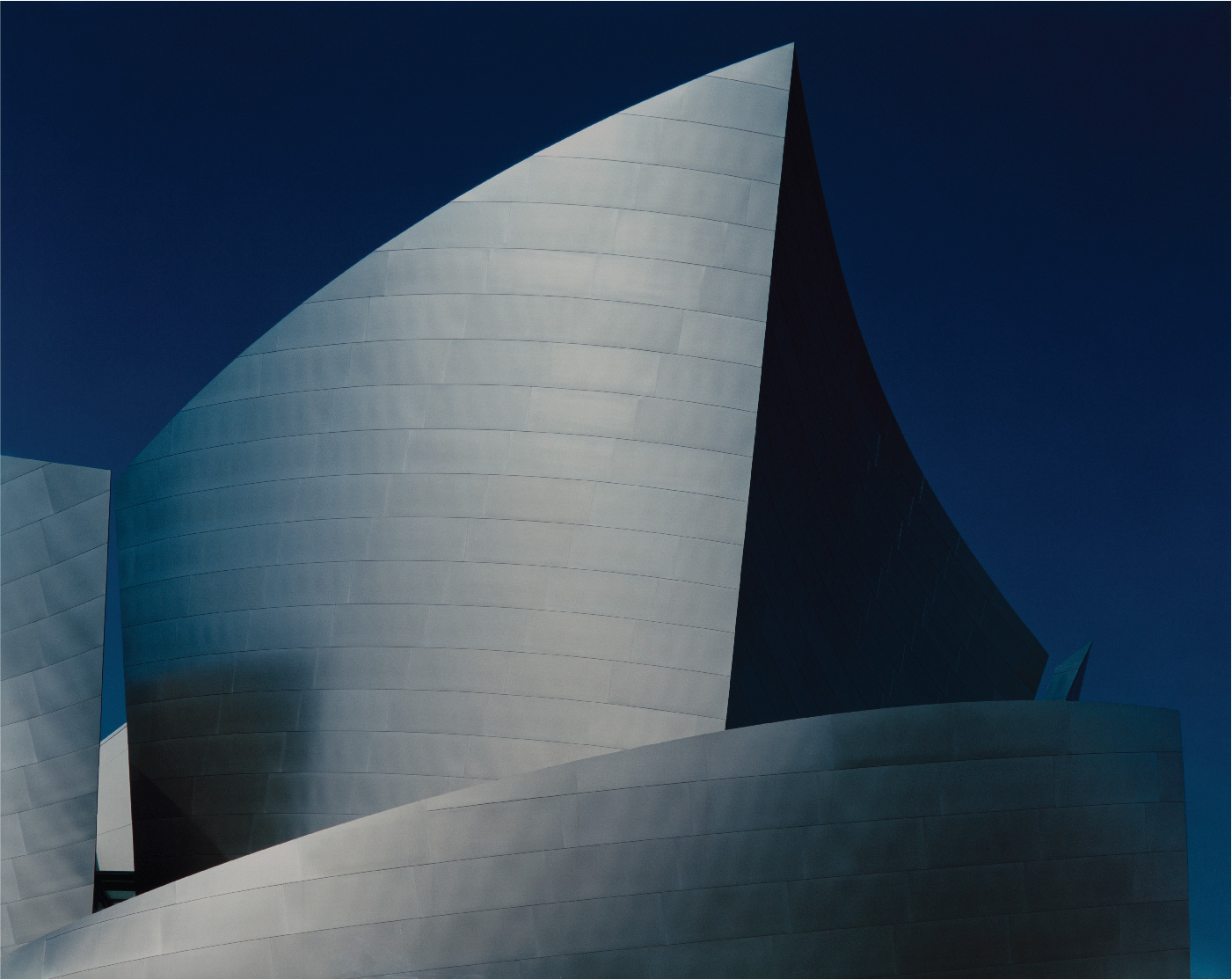
Grant Mudford (Australian, born 1944), Walt Disney Concert Hall, Completed #2, 2003, chromogenic print, 48 × 60 inches. 75th Anniversary gift of William G. Butler, 2014.82.
William G. Butler supported the Palm Springs Art Museum in many ways, including as a member of the Collections Committee. He also gave and promised many prominent works of art to the collection. These include photography, contemporary sculpture, and design objects from the 1960s to the present day.
Following a successful advertising career with his own firm in Manhattan, Butler moved to Palm Springs where he purchased and restored the unconventional Octagon House in 2002, restoring its 1960s design and revolving mechanism. His intellectual and collecting interests range widely, including cinema, live theater, performance art, opera, music, signed rare books and original dramatic scripts.
Butler became an early supporter of the museum’s Architecture and Design Council, including serving as one of its presidents. He was generous with gifts of ceramics and sculpture during his lifetime. However photography was Butler’s main collecting passion. His photography collection includes a focus on architecture and the built environment with such artists as Oliver Boberg, Todd Hido, Grant Mudford, and Mark Ruwedel. Contemporary photographers interested in scientific phenomena such as Brian Bress, Adam Fuss, and Didier Massard represent the conceptual uses of photography. Many of Butler’s prints reflect his fascination with how photographers represent people, especially their performance of identity, including images by Stephen Barker, Eve Fowler, Bill Jacobson, Jack Pierson, Miguel Rio Branco, and August Sander. An experience of place, both physical and psychological, underlies his collecting sensibility and enriches the museum’s holdings through a focus that speaks to the character of Palm Springs.
Michael Childers
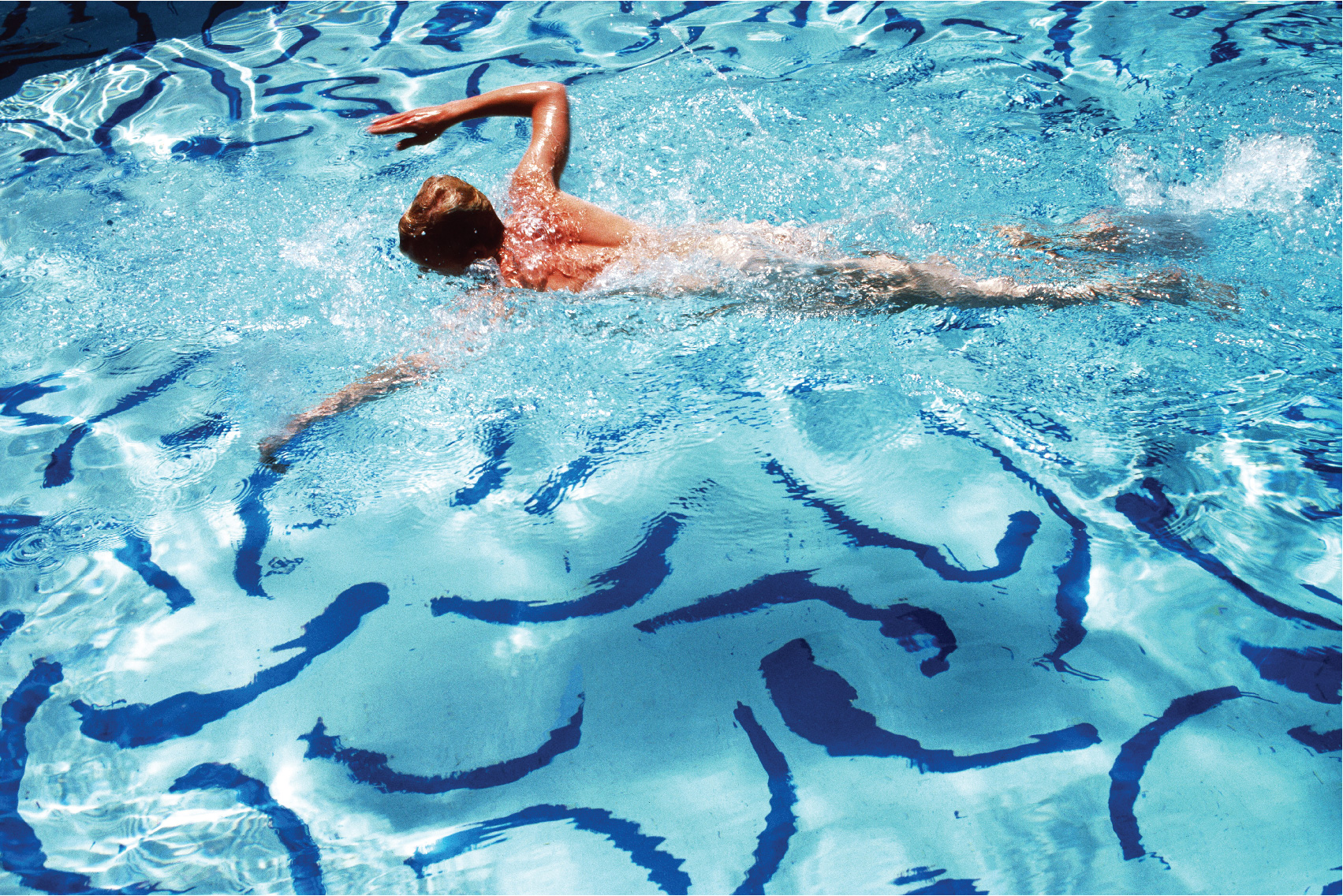
Michael Childers (American, born 1944), The Hockney Swimmer, 1978, C-type print, edition 6/60, 20 x 30 inches. Gift of Michael Childers, 1-2012.
Since the 1960s, Michael Childers has been photographing famous people within the broad genre of portraiture. His long connection to the world of celebrity has given him access to many iconic film stars, artists, and writers of our time—particularly those who make up the creative culture of Southern California and with ties to Palm Springs. His subjects have included Andy Warhol, David Hockney, E. Stewart Williams, Sissy Spacek, Demi Moore, Ringo Starr, and numerous others. As a local resident and supporter of the museum’s photography program, Childers has been an important contributor to the collection—donating his own works and those of his friends and colleagues.
At a young age he began to shoot portraits of his friends, provided photographs for his high school newspaper, and early on demonstrated an interest in fashion and film photography. In 1962, he moved to Los Angeles and began studying at UCLA, which at that time had become a major center for art, film, and photography, and where he received his degree. To support himself, he began photographing friends, musicians, and actors, and over time he met Hollywood golden era film stars, including Norma Shearer, Agnes Moorehead, and Rosalind Russell. He credits celebrity photographer George Hurrell as a major influence on his work. His personal relationship and work with filmmaker John Schlesinger, beginning in 1968, also had a major influence on his life and career.
In 1998, Childers and Schlesinger moved to Palm Springs. In 2002, Childers began donating his photographs to the museum. Today, the Michael Childers Archive is a growing collection of more than 800 examples of his work, including celebrity portraits, nudes, and his two series Distortions and Fusions. They have been featured in the 2003-2004 museum exhibition and publication Icons and Legends: The Photography of Michael Childers and the 2018 exhibition Michael Childers: Having a Ball.
Marilyn Pearl Loesberg and John Renner contributed to the museum collection in a different way—through their many leadership roles as well as through their generosity of gifts. Over many years, each was actively involved with various committees and councils, and, in the case of Loesberg, the board as well. Their passion, knowledge, support, and funding towards art acquisitions, exhibitions, and projects were critical to the ongoing evolution of the art collection.
Marilyn Pearl Loesberg
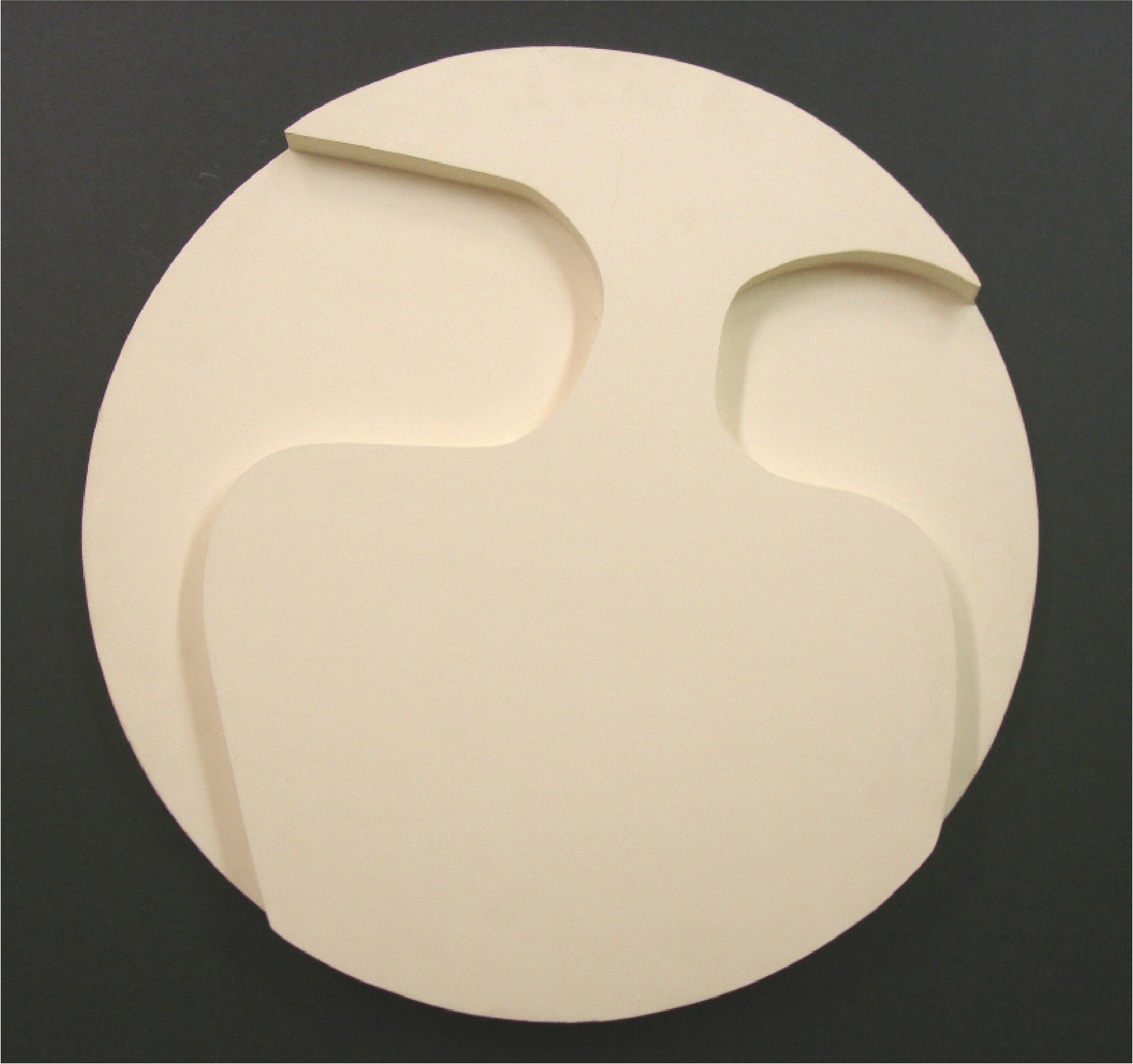
Leon Polk Smith (American, 1906-1996), White Flower A, 1961, painted wood, 23 3/4 inches diameter. Gift of Marilyn Pearl Loesberg and Alan Loesberg, 113-2010.
Marilyn Pearl Loesberg joined the Board of Trustees in 2003, and during her long tenure she has served on the Executive Committee, the Development Committee, and the Collections and Exhibitions Committee. During her affiliation with the museum, she has held many additional roles and participated in a number of other museum committees, including Contemporary Arts Council (President), Photography Collections Council (Vice President), Collectors Forum, and Museum Councils Committee. She also chaired the Artrageous Auction in 2008.
However, Marilyn’s longstanding dedication to the Collections and Exhibitions Committee, which she currently co-chairs with fellow Trustee Leonard Eber, is where she has played her greatest role in terms of the evolution and growth of the museum’s art collection. Since becoming Chair of the Collections Committee in 2006, she has worked closely with multiple museum directors and curators—as well as with numerous other committee members—to consider works of art for acquisition through both purchase and gift. Her experience as an art gallery owner in New York City has been invaluable in providing guidance to the committee.
With her husband Alan Loesberg, she has donated a number of works of art to the museum, including Leon Polk Smith’s outstanding White Flower A, which hangs prominently along with other midcentury paintings. Marilyn’s parents, Selma and Carl Pearl, were also museum trustees, collectively from 1980 to 2002, and likewise donated works of art and financially supported the museum. In 1983, Selma co-founded the Contemporary Art Council, its main goal being to raise money to acquire works of art for the museum. In 2001, she became an Emerita Trustee.
John Renner
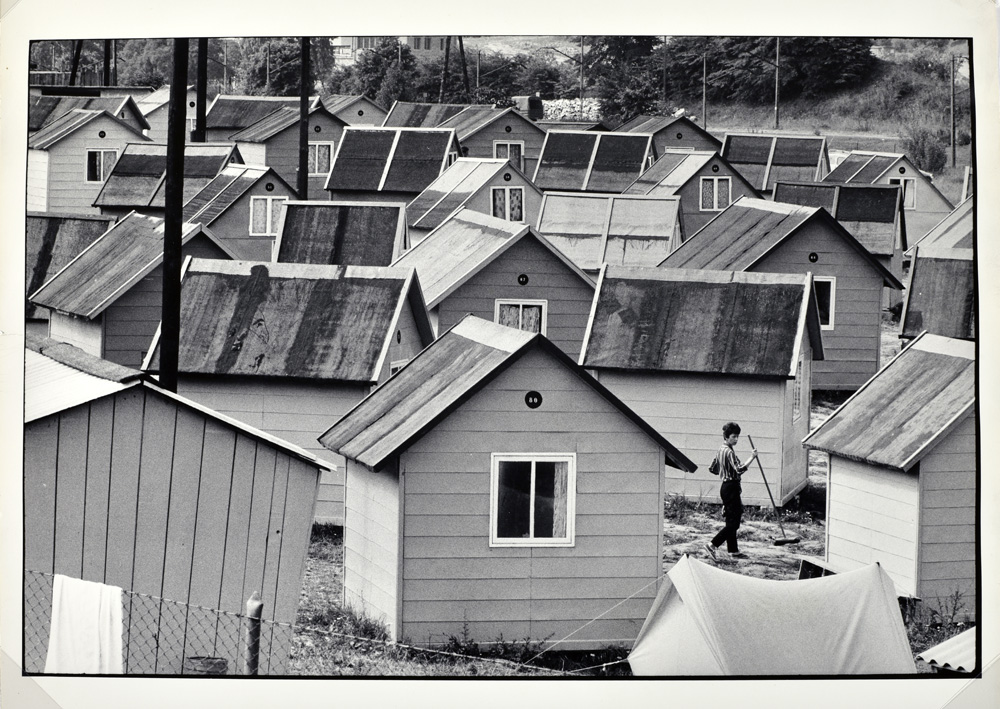
Elliott Erwitt (American, born France, 1928), Woman in midst of shacks, 1964, gelatin silver print, Sheet: 11 × 14 inches. Gift of Philip Gittelman and museum purchase with funds provided by John Renner, Photography Collection Council Chair, 2015.84.
John Renner was a passionate supporter of the museum for more than a decade and one of the earliest members of the Photography Collection Council, which began in 2008. He was Chair of the Council twice, from 2015 to 2016 and again from 2018 to 2019 at the time of his tragic death.
In 2015, he contributed funds towards the acquisition of 64 images by Magnum Photos documentary photographers. Renner regularly funded museum acquisitions, exhibitions, and conservation projects. He volunteered his time and expertise cataloging major photography gifts including those from Michael Childers’ archive, and modern and contemporary photographs from the collection of Dr. and Mrs. J. Patrick Kennedy.
With the support of the museum and his close friends and family, the John Renner Memorial Fund for Photography was established in 2019 (see page 30). As a tribute to his passion for photography, all contributions made to this fund help to support the acquisition, conservation, and preservation of photography at the museum. This fund also honors John’s dedicated leadership in strengthening the museum’s photography collection.
